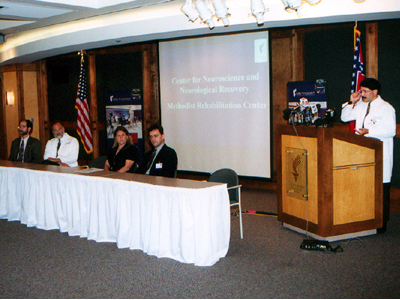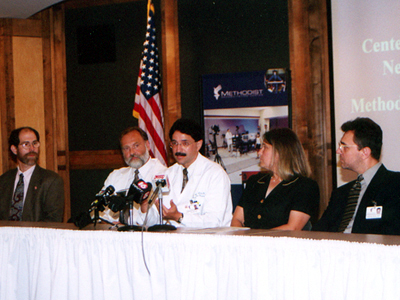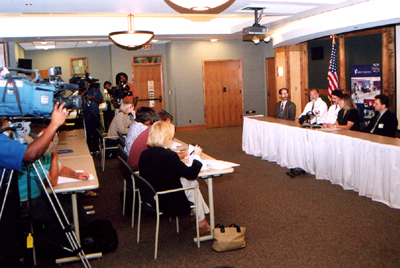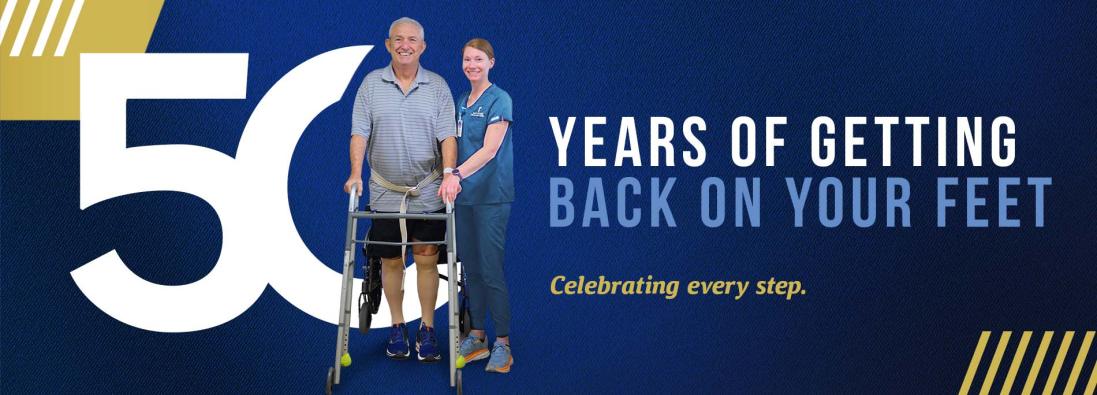



JACKSON, Miss.—Based on findings from the Center for Neuroscience and Neurological Recovery (CNNR) at Methodist Rehabilitation Center, the New England Journal of Medicine today posted on its Web site (nejm.org) research that indicates the West Nile virus may cause an acute poliomyelitis-like syndrome associated with flaccid paralysis. Research findings from the CNNR were also published on Friday by the Centers for Disease Control and Prevention (CDC) in Atlanta in the Morbidity and Mortality Weekly Report. This report offered clinical, laboratory and electrophysiologic guidelines to diagnose poliomyelitis due to West Nile virus. The Journal of the American Medical Association also published the CDC report.
CNNR researchers are the first to report that muscle weakness associated with West Nile virus infection may be caused by a loss of motor cells in the spinal cord and that the virus may be targeting the gray matter of the spinal cord in a manner similar to polio. In early August, the CNNR team advised the CDC and the Mississippi State Department of Health that the acute flaccid paralysis seen in many patients with West Nile virus infection was of spinal cord origin.
Due to the significance of the CNNR’s findings, the CDC and the New England Journal of Medicine expedited the release of their reports.
“Awareness of these findings should be emphasized by public health organizations so that incorrect diagnoses and the morbidity and mortality associated with inappropriate treatment can be avoided,” said the study’s principal investigator, Dr. Art Leis, a neurologist and CNNR senior scientist.
When Charles Gibbs, of Clinton, Miss., came to Methodist Rehabilitation Center after a month-long illness, Dr. Leis examined him and was startled by what he found. “When I performed electrodiagnostic testing, I realized that the findings were entirely consistent with an attack upon the gray matter of the spinal cord. There were muscle groups in this patient that were entirely without a nerve supply, because the motor neurons in the spinal cord had been destroyed.”
Gibbs doesn’t remember being bitten by mosquitoes before he got sick. “I was working in the yard and started getting chills,” he recalled. “I went inside, crawled into the bed and covered up with a blanket. I slept till 6:30 the next morning.”
It took several weeks before doctors were able to confirm that Gibbs had the West Nile virus. Early suspected diagnoses included a stroke and Guillain-Barre—a syndrome that involves the peripheral nerves and can also cause acute flaccid paralysis and diagnostic confusion.
After transfer to Methodist Rehab, Gibbs underwent intensive therapy, trying to regain some lost function in his arms and legs. Although he is getting stronger, he remains very weak.
Dr. Micheal Winkelmann, a physiatrist (a physician who specializes in physical medicine) at Methodist Rehab who treats many patients with post-polio syndrome, and physiatrist Dr. Jo Lynn Polk alerted Dr. Leis to the polio-like presentation in three more West Nile patients with acute flaccid paralysis. Electrodiagnostic studies confirmed poliomyelitis.
“Our experience with all patients admitted to Methodist Rehab with West Nile virus infection suggests that the gray matter of the spinal cord is indeed a primary target of the virus”, said Dr. Victor Dostrow, a staff neurologist at Methodist Rehab who consulted on these patients.
Prior to the CNNR's findings, national and local health guidelines emphasized that the West Nile virus was an attack on the brain and could cause encephalitis and meningitis.
Although this remains true, the CNNR research indicates that the virus can also attack the motor neurons of the spinal cord that control muscle function, causing severe muscle weakness.
“What we’ve discovered is significant and will enable physicians and public health workers nationwide to better characterize this illness,” said Dr. Dobrivoje Stokic, director of the CNNR. “Our findings have greatly advanced the understanding of the spectrum of clinical presentations of West Nile virus infection.”
The first outbreak of West Nile virus in the United States occurred in 1999 when 62 people were hospitalized and seven died in New York. When reading the first autopsy reports, Dr. Leis noted that the brains were mostly unaffected and that all four patients were profoundly weak, suggesting that muscle weakness may be a significant risk factor in predicting morbidity and mortality.
“More than half of the confirmed West Nile cases have displayed severe muscle weakness,” Dr. Leis added. “Yet, this important symptom had previously received little scientific scrutiny and is still without a defined pathological basis. Ongoing collaborative research is aimed at obtaining pathological confirmation of our clinical findings.”
CNNR researchers suggest that physicians be aware of four symptoms of possible West Nile poliomyelitis:
- Asymmetrical muscle weakness—where one arm or leg is weaker than the other
- An absence or decrease in deep tendon reflexes
- Acute change in bowel or bladder function
- Respiratory muscle weakness especially where endotrachial intubation and mechanical ventilation is necessary
CNNR researchers hope that an increased awareness that the virus may target the spinal cord will result in better diagnoses and more appropriate treatments.
“If doctors see patients with symptoms that suggest involvement of the gray matter of the spinal cord—particularly in combination with fever, chills and headaches—with or without meningitis or encephalitis, then these patients should be tested for West Nile virus by sending serum to the Department of Health.
“A more accurate diagnosis and treatment will also lead to more accurate assessment of the effectiveness of prevention activities and mosquito control in humans,” added Dr. Leis.
